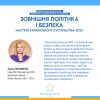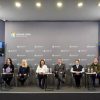Comment by Leo Litra for the Italian think-tank ISPI.
When a journalist asked Ukraine’s Foreign Minister, Dmytro Kuleba, to name a “red line” which would make him resign, he said that it would be the abandonment of Ukraine’s pro-Western course. The words of Minister Kuleba very tellingly describe the essence and drivers of efforts and reforms in Ukraine.
In April 2019, Volodymyr Zelensky was elected president of Ukraine, replacing Petro Poroshenko. But just before Zelensky’s election, Poroshenko managed to push for constitutional amendments that now include aspirations to join the EU and NATO. Although the amendment of the constitution has rather symbolic implications, it was a sign of the unity of the political class with regard to Euro-Atlantic integration. It was also a test for Zelensky’s presidency, amid growing concerns before he assumed the mandate, that the new president would not be firmly committed to Ukraine’s Euro-Atlantic stance.
After one year of his presidency, Zelensky has actually proven his attachment to Euro-Atlantic aspirations and relations with the West. However, Zelensky’s approach to relations with the West, and the EU and NATO in particular, have demonstrated a different approach from that of his predecessor.
Above all, the question of the Russia-backed conflict in Donbas became central to Zelensky’s policy, inadvertently making relations with the EU and NATO a secondary priority. This reflected very much on the perception of Zelensky’s foreign policy agenda. Probably for the first time since the Euromaidan protests, also known as the “Revolution of Dignity”, admission to the EU is not perceived as “cool” in the presidential office, government and the parliament, but rather as a mechanical process. Zelensky’s new approach to internalizing the EU and making it less of a political dictum does not necessarily mean that EU integration was sidelined. On the contrary, Zelensky’s presidency had a very good start by pushing for a series of laws and reforms which were not prioritized by the previous administration. In a matter of weeks, the new parliament showed good results at high speed, a process which was coined as “turbo-mode” and covered especially the business environment and public finance. For instance, an investment incentive law was adopted that aimed to improve the investment environment and boost foreign investments in Ukraine. Despite the turbo-mode, Zelensky’s progress was not linear, especially when it came to implementation of the Association Agreement – the key framework document forming the agenda between the EU and Ukraine. In 2019, only 37% of planned actions were implemented, compared to 52% in 2018. Institutionally, Verkhovna Rada had the lowest level of implementation of the Association Agreement, reaching only 12%. This weak performance is explained by the 2019 electoral year, which was not only paralyzed by presidential elections, but also by the elections of parliament following its dissolution once Zelensky assumed office, and the high volatility of various decision makers’ positions.
The fact that the EU is almost absent from the speeches of high-level officials, except line ministers, is the new norm which characterizes Zelensky’s strategy: to manage expectations regarding the EU and potential membership and not pretend that Ukraine is embarking on processes that are in fact not available for Kyiv – i.e. membership. For Zelensky, it is important not to permit any roll-back on what has been already achieved. On top of that, he is looking for practical achievements, such as the signing of the “industrial visa-free” (ACAA) agreement, revision of the Association Agreement and the inclusion of Ukraine in the EU’s announced Green Deal. President Zelensky also focused on cultivating bilateral relations with EU member states (Germany, France and Italy) rather than with the EU and its institutions, showing his belief that much could be pushed forward with the support of powerful EU member states.
As for NATO, like relations with the EU, Ukraine currently looks for practical results and has dropped the active narrative on membership. Zelensky showed commitment to NATO and one could mention that he seems to be more attached to NATO now than before elections. He proved this by appointing Vadym Prystaiko, a pro-NATO diplomat, as foreign minister and since March as deputy prime minister in charge of European and Euro-Atlantic integration. For now, Ukraine wants to compensate for the lack of progress regarding membership with its inclusion in the NATO Enhanced Opportunity Program, which is widely supported within NATO, including by the US; however, some important NATO members are still hesitant in order not to irritate Russia. Second, Kyiv wants to fully renew the work of the Ukraine-NATO Commission that was blocked by Budapest following disagreements with Kyiv over the education law. Third, Kyiv wants to modernize the comprehensive package of assistance to Ukraine. Finally, Ukraine intends to implement NATO standards by 2024, which is a very ambitious, although not impossible, task.
To a great extent, the first year of Zelensky’s presidency was marked by inertia in relations with the West, particularly with the EU and NATO. However, Zelensky enters his second year on his own terms. Above all by further prioritizing the settlement in Donbas, by lowering expectations regarding EU membership and by promoting bilateralism with EU countries over EU multilateralism.







